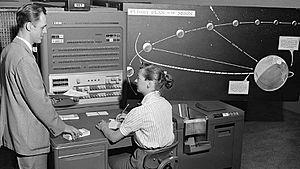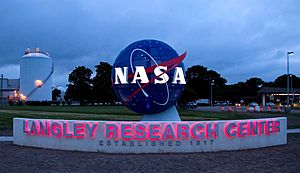Virginia Tucker facts for kids
Quick facts for kids
Virginia Layden Tucker
|
|
|---|---|
| Born | 1909 |
| Died | (aged 75) |
| Alma mater | North Carolina College for Women |
| Employer |
|
| Organization | Society of Women Engineers |
Virginia Layden Tucker (1909 – January 19, 1985) was a smart American mathematician. She helped engineers design and make airplanes better. She worked for an organization called the National Advisory Committee for Aeronautics (NACA). This was the group that later became NASA, which explores space! Virginia was one of the first "human computers". This meant she did math calculations by hand. She also helped find and train other women for this important job. Later, she worked on how air moves around planes (aerodynamics). She also spoke up for women who wanted to work in math.
Contents
Early Life and Education
Virginia Tucker was born in Hertford, North Carolina in 1909. She was a very bright student. In 1926, she was the top student in her high school's first graduating class.
She then went to the North Carolina College for Women. In 1930, she earned a degree in mathematics. She also studied education, which helped her become a teacher.
Becoming a Human Computer
After college, Virginia taught high school math for four years. In 1935, she got a special job offer. She was asked to work at the Langley Memorial Aeronautical Laboratory. This was the main research center for the NACA.
Virginia was one of only five women chosen for Langley's first "computer pool." At that time, there were no electronic computers like we have today. So, these women were the "human computers." Their job was to do all the complex math. They processed huge amounts of data from flight tests and wind tunnel experiments. This data was super important for designing new airplanes.
Helping During World War II
When World War II started in 1939, making better airplanes became very important for the U.S. Military. Because of this, the need for human computers grew quickly.
Virginia Tucker traveled all over the country, especially in the southern states. Her mission was to find and train more talented women mathematicians. These women would join the program and help with the war effort.
By 1946, Virginia was promoted to a big role. She became the Overall Supervisor for Computing at Langley. She was in charge of about 400 female "human computers." Many of them were women she had personally recruited and trained!
Advocating for Women in STEM
In 1948, Virginia left the NACA. She started working as a researcher at the Northrop Corporation, an aerospace company.
She also became a strong supporter for women in engineering. She worked with the Society of Women Engineers (SWE). She was a director for the Los Angeles branch of SWE. She also helped manage SWE's money as chair of their National Finance Committee from 1955 to 1956. In 1957, she represented SWE at a council for technical societies in Los Angeles.
Later Life and Legacy
After 17 years at Northrop, Virginia Tucker returned to North Carolina. She became a supervisor for a local school system. She worked there until she retired in 1974.
Virginia Tucker passed away on January 19, 1985, when she was 75 years old. Her work as a "human computer" and her efforts to support women in math and engineering helped shape the future of aviation and inspire many others.
Images for kids





